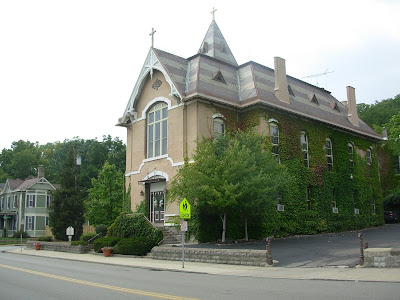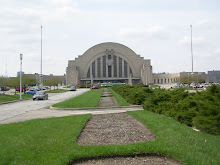Cincinnati grew in size and in population through a series of annexations. These began in 1849 with the annexation of Over the Rhine, north of Liberty, and continued well in to the 20th Century. The neighborhoods of today were in many cases once incorporated towns and villages. And as separate towns, they often had their own town halls and amenities like fire departments, libraries and such. One such community was Linwood, north and west of Columbia Tusculum.
.jpg)
The village of Linwood was incorporated in 1874. Linwood became a popular residential community with easy access to Cincinnati by Wooster Pike and the Little Miami Railroad. Eventually business development grew including industry and a small business district. Early manufacturing for instance included the Linwood Furniture Company and eventually, in the early 1890’s, the R.K. LeBlond Machine Tool Company. However in 1896, the village was annexed to the City of Cincinnati and the separate town ceased to exist.
.jpg)
A reminder of their independent past is their still standing, quaint Linwood Town Hall at 4936 Eastern Avenue.
.jpg)
Built in 1874, the style of the building is commonly referred to as "Stick Style" by the decorative wood detailing on the exterior including that in the gables, eaves, the bracketed cornice, and upper portions of the tower. Stick Style seems to be rare for a public building and elements of the building to me also exude Queen Anne which is similar to Stick and dates from the same time period. The architect of the structure is unknown. Sue Ann Painter’s book Architecture in Cincinnati does not indicate an architect and recent personal searches have come up empty.
.jpg)
.jpg)
For a time after annexation in 1896, I do not know what the building was used for. However in 1903, James Heekin, President of the Heekin Can Company, the Heekin Spice Company, and the James Heekin Company, purchased the town hall and donated it to the Archdiocese of Cincinnati. (It should be noted in a ‘Behind the Asphalt’ way that the Town Hall is located at the corner of Eastern Avenue and Heekin Street, named for James Heekin who would also be President of the Cincinnati Chamber of Commerce from 1910 – 1911.)
So in 1903, Our Lady of Loretta Catholic Parish was formed, carved out of St. Stephan’s Parish in Columbia-Tusculum, and began use of the building as their church. (The crosses on the building you see are an "church" addition.) This lasted until they closed in 1995 and merged with St. Margaret of Cortona. The photo below is of the building as Our Lady of Loretta Catholic Church.

The building is now owned by Ark of the River Church.
This post was informed by a section in Architecture in Cincinnati which includes the Linwood Town Hall and two other town hall examples in Cincinnati. The first being the Westwood Town Hall completed in 1889 and designed by Crapsey & Brown. The second is the College Hill Town Hall completed in 1886 and designed by Samuel Hannaford. The College Hill Town Hall (1805 Larch Avenue) is on the National Register of Historic Places and the Westwood Town Hall (3017 Harrison Avenue) is part of the Westwood Town Center Historic District.
College Hill Town Hall
.jpg)
Westwood Town Hall
.jpg)
I chose Linwood Town Hall for its charm and rather delicateness and probably because I felt it could use a little recognition. It is the only one of the three not on the National Register and I feel it certainly is worthy. The other town halls are probably nicer in some ways and they are certainly more civic in their feel and setting but Linwood should not be overlooked.
References:
History of Cincinnati & Hamilton County, 1894
Miller, Zane. Boss Cox’s Cincinnati. University of Chicago Press, Chicago, IL: 1968
Painter, Sue Ann. Architecture of Cincinnati. Ohio University Press, Athens, OH: 2006
Historic image from Library’s Cincinnati Memory Project
.jpg)

2 comments:
I agree with you on the terrific Linwood town hall, but I wonder if you don't have the Westwood and College Hill pictures reversed.
Radarman - I do! Argh. I'll fix it later today! Thanks for the catch.
Post a Comment